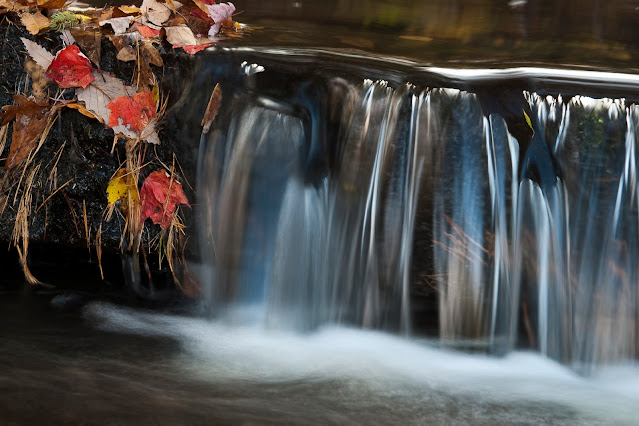This discussion all began with a critique by a fellow photographer stating that his preference for showing moving water was with the camera "freezing" movement. He preferred that and suggested long exposures were artificial. So, he viewed the creamy texture seen below as not natural.
The exposure for the above image was slow, 0.8 seconds. I liked this because it gives a feeling of gentle flowing water. It occurs to me that before the invention of the camera shutter, we had no idea of what any moving subject looked like. Before that, we could not see crashing drops of water spilling over a water fall, or the wings of the Goldfinch launching into flight seen below. It was a blur.
 Time itself is a human invention. It was developed for navigators to determine longitude. Then it was extended in the industrial revolution to economically quantify labor delivered, and later refined to coordinate railroad schedules across wide distances. Moving pictures use the shutter to create a stack of still images which, when displayed sequentualy at 25 frames per second, create an illusion of motion. Again, that is not natural but a human artifice.
Time itself is a human invention. It was developed for navigators to determine longitude. Then it was extended in the industrial revolution to economically quantify labor delivered, and later refined to coordinate railroad schedules across wide distances. Moving pictures use the shutter to create a stack of still images which, when displayed sequentualy at 25 frames per second, create an illusion of motion. Again, that is not natural but a human artifice. Our perception of time is also shaped by the speed that our brain processes what we see, clock speed. If you are driving behind a truck and something falls off the truck and into your lane, it takes your brain about 250 milliseconds to send the orders to your muscles to brake sharply. That's 1/4 second. That won't work for the Louisiana Waterthrush at right. Survival demands increased speed to capture little water bugs. So, our human perception of time is not universal. Our clock speed is natural for us, but not for all creatures.
Our perception of time is also shaped by the speed that our brain processes what we see, clock speed. If you are driving behind a truck and something falls off the truck and into your lane, it takes your brain about 250 milliseconds to send the orders to your muscles to brake sharply. That's 1/4 second. That won't work for the Louisiana Waterthrush at right. Survival demands increased speed to capture little water bugs. So, our human perception of time is not universal. Our clock speed is natural for us, but not for all creatures. Here's a big idea. The shutter allows us to switch to a new perception of time. It freezes a bird in flight on one side, and alternately revises how we interpret the sea swirling over a rocky coast or how we see a waterfall. I want to explore how very long exposures present a different interpretation of time. Below is a winter favorite of mine, Taughannock Falls in nearby Trumansburg, New York. The gorge and waterfall were created over a span of about ten thousand years following the last ice age. It is winter now, so ice is appropriate.
The view from the north wall is in two layers - a warmly lit foreground that is crisply defined and the distant falls in cool blue light. To me, stopping the water's movement is not what my eyes see. The gorge walls are reasonably defined so the creamy water speaks for falling water.
There's an easy hike from near Cayuga Lake up the gorge to near the big falls.
On both sides of the falling water, there is a constantly evolving filigree of ice formed as varying winds paint patterns of ice. This was a 1.6 second shutter. My mind is wrapped in a slower clock speed. I want to distill the scene even more. I really pushed the clock speed to 48 seconds.
What feelings does this create for you? For me, I feel the cold, raw power of Taughannock.
As one retreats back down the gorge, there is a final waterfall that is more complex than the big drop. It offers some delightful forms to explore with slower shutters. (I am keeping these images in a cold, blue light because that's usually what my cold hands are feeling like after two hours in the gorge.)
Shifting my lens to the left, I discover another ice sculpture that would be missed at a fast shutter.
It is now five days past when I saw these frozen falls. We have had three days of very warm, above freezing temperatures. The ice is nearly gone, but I know the cold will return and create new ice forms. I'll be back to find new ice sculpturess at a slower clock speed.
Paul Schmitt





